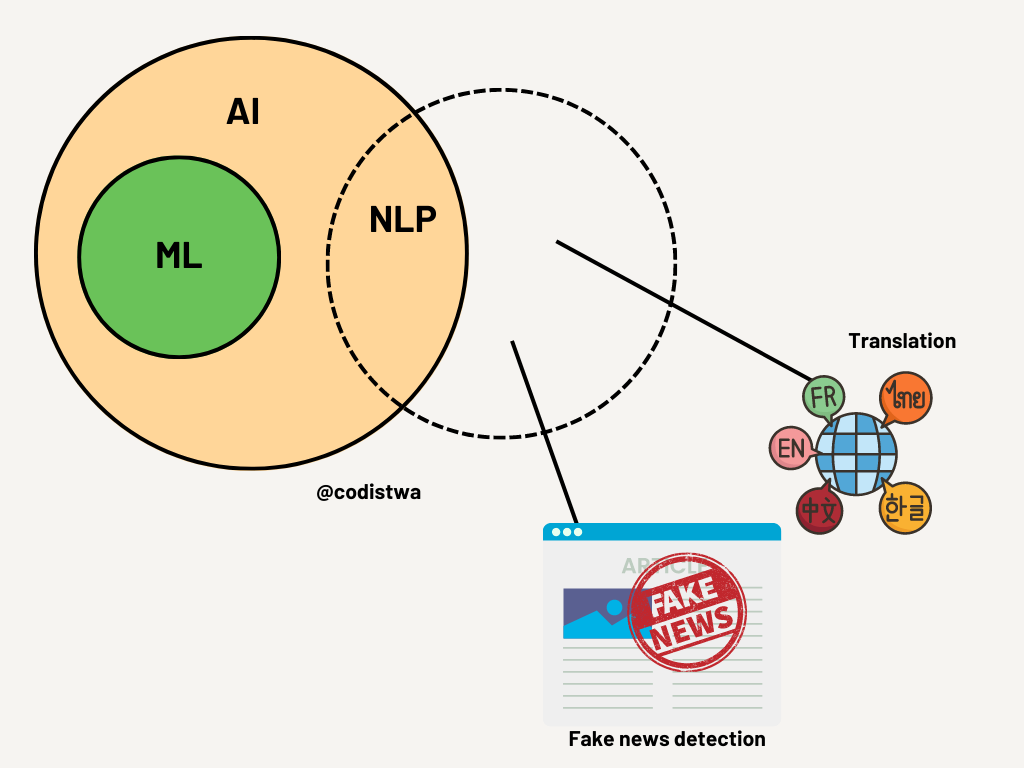Assitan Koné
Jun 1
AI, Machine Learning, and NLP: What are the Differences?
Do you know the differences between AI, Machine Learning, and NLP? While the terms are often used interchangeably, each field has its own unique focus and applications.
You can watch the video on YouTube:
Artificial intelligence: combining everything
Artificial intelligence (AI) involves the development of intelligent machines that can perform tasks that typically require human intelligence. The goal is to enable machines to learn, reason, and solve problems in a way that mimics human cognitive processes.
There are two types of AI - Narrow AI (also known as Weak AI or Applied AI) and General AI (also known as Strong AI or Human-level AI). Narrow AI refers to AI systems designed to perform specific tasks or solve problems within a limited domain. These systems excel in specific areas, are built using machine learning techniques like supervised or unsupervised learning, and are trained on specific datasets relevant to the task. Examples of Narrow AI include image or speech recognition, natural language processing, recommendation systems, fraud detection, and autonomous driving.
On the other hand, General AI aims to exhibit human-level intelligence across a wide range of cognitive abilities. This means that General AI involves developing machines that can understand and apply knowledge, reason, plan, learn, communicate, and adapt to new situations in a manner comparable to human intelligence. General AI systems would possess a comprehensive understanding of the world and be capable of engaging in meaningful conversations, exhibiting common-sense reasoning, and effectively handling a wide range of complex tasks. Examples of General AI can be seen in science fiction movies like I-Robot.


Machine Learning: a subset of AI to make predictions
Machine Learning is a subset of AI that involves algorithms and statistical models that enable machines to learn from data rather than being explicitly programmed. This allows machines to improve their performance over time.
It uses statistical techniques to enable machines to automatically improve their performance on a specific task without being explicitly programmed.
Machine Learning systems are trained on large datasets, enabling them to identify patterns, make predictions, and perform tasks without being explicitly programmed.
The core concept revolves around training models on data to acquire knowledge and make accurate predictions or decisions.
Machine learning algorithms can be broadly classified into three types: supervised learning, unsupervised learning, and reinforcement learning.

Natural Language Processing: a subset of AI to understand, interpret, and generate human language
NLP is another subset of AI focusing specifically on the interaction between humans and computers using natural language. NLP allows machines to understand, interpret, and generate human language, essential for building chatbots and other applications requiring natural language processing. This has applications in fields such as customer service and healthcare.
NLP techniques include speech recognition, text-to-speech conversion, sentiment analysis, language translation, and question-answering systems. NLP utilizes computational linguistics, machine learning, and AI to process and analyze large amounts of textual and linguistic data, allowing machines to comprehend and generate human language.

Conclusion
Understanding the differences between these fields is important for understanding the capabilities and limitations of modern AI technology. By differentiate how AI, ML, and NLP work, we can better appreciate the possibilities and limitations of these powerful tools.
In conclusion, AI, ML, and NLP are all important fields in modern technology, each with its own distinct focus and applications. As these fields evolve, it is important to keep up with the latest developments and understand how they can be applied to solve complex problems and improve our lives.
#MachineLearning #TechEducation #AIForBeginners #DeepLearning #DataScience #AI #ArtificialIntelligence #DataScienceMentorship
Want to talk about your project idea or get help finding the right one?
I offer a free 30-minute strategy call to help you:
- Get clarity on your goals
- Understand how real-world projects can unlock your next step
- See if the Accelerator is the right fit for you
Spots are limited, I work with a small number of mentees at a time.
Latest from our blog

Mentorship for underrepresented talent in AI/ML
Real projects, real businesses, real transformation
Copyright ©TwaKaToz 2025

